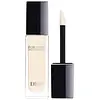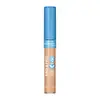What's inside
What's inside
 Key Ingredients
Key Ingredients

 Benefits
Benefits

 Concerns
Concerns

 Ingredients Side-by-side
Ingredients Side-by-side

Water
Skin ConditioningC9-12 Alkane
SolventCaprylic/Capric Triglyceride
MaskingPropanediol
SolventGlycerin
HumectantPolyglyceryl-6 Polyricinoleate
EmulsifyingDicaprylyl Ether
EmollientPentylene Glycol
Skin ConditioningSilica
AbrasivePolyglyceryl-10 Decaisostearate
EmollientSynthetic Fluorphlogopite
Trimethylsiloxysilicate
EmollientIris Florentina Root Extract
MaskingPolyglyceryl-2 Isostearate
EmulsifyingDisteardimonium Hectorite
StabilisingSodium Myristoyl Glutamate
CleansingStearalkonium Hectorite
Gel FormingSodium Chloride
MaskingButylene Glycol
HumectantLecithin
EmollientHydroxyacetophenone
AntioxidantSodium Benzoate
MaskingPropylene Carbonate
SolventPolyhydroxystearic Acid
EmulsifyingHydrolyzed Viola Tricolor Extract
Skin ProtectingAluminum Hydroxide
EmollientParfum
MaskingTocopherol
AntioxidantIsostearic Acid
Cleansing1,2-Hexanediol
Skin ConditioningCaprylyl Glycol
EmollientPolyglyceryl-3 Polyricinoleate
EmulsifyingAchillea Millefolium Extract
CleansingXanthan Gum
EmulsifyingTropaeolum Majus Flower/Leaf/Stem Extract
Skin ConditioningCitric Acid
BufferingPotassium Sorbate
PreservativeCI 77891
Cosmetic ColorantCI 77491
Cosmetic ColorantCI 77492
Cosmetic ColorantCI 77499
Cosmetic ColorantWater, C9-12 Alkane, Caprylic/Capric Triglyceride, Propanediol, Glycerin, Polyglyceryl-6 Polyricinoleate, Dicaprylyl Ether, Pentylene Glycol, Silica, Polyglyceryl-10 Decaisostearate, Synthetic Fluorphlogopite, Trimethylsiloxysilicate, Iris Florentina Root Extract, Polyglyceryl-2 Isostearate, Disteardimonium Hectorite, Sodium Myristoyl Glutamate, Stearalkonium Hectorite, Sodium Chloride, Butylene Glycol, Lecithin, Hydroxyacetophenone, Sodium Benzoate, Propylene Carbonate, Polyhydroxystearic Acid, Hydrolyzed Viola Tricolor Extract, Aluminum Hydroxide, Parfum, Tocopherol, Isostearic Acid, 1,2-Hexanediol, Caprylyl Glycol, Polyglyceryl-3 Polyricinoleate, Achillea Millefolium Extract, Xanthan Gum, Tropaeolum Majus Flower/Leaf/Stem Extract, Citric Acid, Potassium Sorbate, CI 77891, CI 77491, CI 77492, CI 77499
Water
Skin ConditioningDicaprylyl Carbonate
EmollientDicaprylyl Ether
EmollientAluminum Starch Octenylsuccinate
AbsorbentGlycerin
HumectantTrimethylsiloxysilicate
EmollientSodium Chloride
MaskingTri (Polyglyceryl-3/Lauryl) Hydrogenated Trilinoleate
EmulsifyingSilica
AbrasiveStearalkonium Bentonite
Gel FormingCetyl PEG/PPG-10/1 Dimethicone
EmulsifyingMica
Cosmetic ColorantPropylene Carbonate
SolventTocopherol
AntioxidantPanthenol
Skin ConditioningTriethoxycaprylylsilane
Sodium Benzoate
MaskingChlorphenesin
AntimicrobialAloe Barbadensis Leaf Juice
Skin ConditioningMethicone
EmollientPantolactone
HumectantPentaerythrityl Tetra-Di-T-Butyl Hydroxyhydrocinnamate
AntioxidantCI 77891
Cosmetic ColorantIron Oxides
Water, Dicaprylyl Carbonate, Dicaprylyl Ether, Aluminum Starch Octenylsuccinate, Glycerin, Trimethylsiloxysilicate, Sodium Chloride, Tri (Polyglyceryl-3/Lauryl) Hydrogenated Trilinoleate, Silica, Stearalkonium Bentonite, Cetyl PEG/PPG-10/1 Dimethicone, Mica, Propylene Carbonate, Tocopherol, Panthenol, Triethoxycaprylylsilane, Sodium Benzoate, Chlorphenesin, Aloe Barbadensis Leaf Juice, Methicone, Pantolactone, Pentaerythrityl Tetra-Di-T-Butyl Hydroxyhydrocinnamate, CI 77891, Iron Oxides
 Reviews
Reviews

Ingredients Explained
These ingredients are found in both products.
Ingredients higher up in an ingredient list are typically present in a larger amount.
Ci 77891 is a white pigment from Titanium dioxide. It is naturally found in minerals such as rutile and ilmenite.
It's main function is to add a white color to cosmetics. It can also be mixed with other colors to create different shades.
Ci 77891 is commonly found in sunscreens due to its ability to block UV rays.
Learn more about CI 77891Dicaprylyl Ether is created from caprylic acid. It is a texture-enhancer and emollient.
As an emollient, Dicaprylyl Ether is non-comedogenic. It helps soften and smooth the skin by creating a barrier on top. This barrier helps trap moisture in, helping to hydrate the skin.
Dicaprylyl Ether gives a non-greasy feel and better spreadability to products.
Learn more about Dicaprylyl EtherGlycerin is already naturally found in your skin. It helps moisturize and protect your skin.
A study from 2016 found glycerin to be more effective as a humectant than AHAs and hyaluronic acid.
As a humectant, it helps the skin stay hydrated by pulling moisture to your skin. The low molecular weight of glycerin allows it to pull moisture into the deeper layers of your skin.
Hydrated skin improves your skin barrier; Your skin barrier helps protect against irritants and bacteria.
Glycerin has also been found to have antimicrobial and antiviral properties. Due to these properties, glycerin is often used in wound and burn treatments.
In cosmetics, glycerin is usually derived from plants such as soybean or palm. However, it can also be sourced from animals, such as tallow or animal fat.
This ingredient is organic, colorless, odorless, and non-toxic.
Glycerin is the name for this ingredient in American English. British English uses Glycerol/Glycerine.
Learn more about GlycerinThis ingredient is a solvent. It helps dissolve active ingredients and alter the texture of products.
Propylene Carbonate is commonly used in makeup and with clay, such as montmorillonite or bentonite.
Studies show this ingredient to be safe for cosmetics. When it is undiluted, it can cause skin irritation. (It is always diluted in skincare and makeup). This ingredient is water-soluble.
Propylene Carbonate is created from propylene glycol and carbonic acid.
Learn more about Propylene CarbonateSilica, also known as silicon dioxide, is a naturally occurring mineral. It is used as a fine, spherical, and porous powder in cosmetics.
Though it has exfoliant properties, the function of silica varies depending on the product.
The unique structure of silica enhances the spreadability and adds smoothness, making it a great texture enhancer.
It is also used as an active carrier, emulsifier, and mattifier due to its ability to absorb excess oil.
In some products, tiny microneedles called spicules are made from silica or hydrolyzed sponge. When you rub them in, they lightly polish away dead skin layers and enhance the penetration of active ingredients.
Learn more about SilicaSodium Benzoate is a preservative. It's used in both cosmetic and food products to inhibit the growth of mold and bacteria. It is typically produced synthetically.
Both the US FDA and EU Health Committee have approved the use of sodium benzoate. In the US, levels of 0.1% (of the total product) are allowed.
Sodium benzoate works as a preservative by inhibiting the growth of bacteria inside of cells. It prevents the cell from fermenting a type of sugar using an enzyme called phosphofructokinase.
It is the salt of benzoic acid. Foods containing sodium benzoate include soda, salad dressings, condiments, fruit juices, wines, and snack foods.
Studies for using ascorbic acid and sodium benzoate in cosmetics are lacking, especially in skincare routines with multiple steps.
We always recommend speaking with a professional, such as a dermatologist, if you have any concerns.
Learn more about Sodium BenzoateChances are, you eat sodium chloride every day. Sodium Chloride is also known as table salt.
This ingredient has many purposes in skincare: thickener, emulsifier, and exfoliator.
You'll most likely find this ingredient in cleansers where it is used to create a gel-like texture. As an emulsifier, it also prevents ingredients from separating.
There is much debate on whether this ingredient is comedogenic. The short answer - comedogenic ratings don't tell the whole story. Learn more about comegodenic ratings here.
The concensus about this ingredient causing acne seems to be divided. Research is needed to understand if this ingredient does cause acne.
Scrubs may use salt as the primary exfoliating ingredient.
Learn more about Sodium ChlorideTocopherol (also known as Vitamin E) is a common antioxidant used to help protect the skin from free-radicals and strengthen the skin barrier. It's also fat soluble - this means our skin is great at absorbing it.
Vitamin E also helps keep your natural skin lipids healthy. Your lipid skin barrier naturally consists of lipids, ceramides, and fatty acids. Vitamin E offers extra protection for your skin’s lipid barrier, keeping your skin healthy and nourished.
Another benefit is a bit of UV protection. Vitamin E helps reduce the damage caused by UVB rays. (It should not replace your sunscreen). Combining it with Vitamin C can decrease sunburned cells and hyperpigmentation after UV exposure.
You might have noticed Vitamin E + C often paired together. This is because it is great at stabilizing Vitamin C. Using the two together helps increase the effectiveness of both ingredients.
There are often claims that Vitamin E can reduce/prevent scarring, but these claims haven't been confirmed by scientific research.
Learn more about TocopherolThis silicone is an emollient. Emollients create a thin film on the skin to prevent moisture from escaping.
It is not soluble in water and helps increase water-resistance in products.
According to a manufacturer, it can blend seamlessly with silicone oils, such as Cyclopentasiloxane.
Learn more about TrimethylsiloxysilicateWater. It's the most common cosmetic ingredient of all. You'll usually see it at the top of ingredient lists, meaning that it makes up the largest part of the product.
So why is it so popular? Water most often acts as a solvent - this means that it helps dissolve other ingredients into the formulation.
You'll also recognize water as that liquid we all need to stay alive. If you see this, drink a glass of water. Stay hydrated!
Learn more about Water